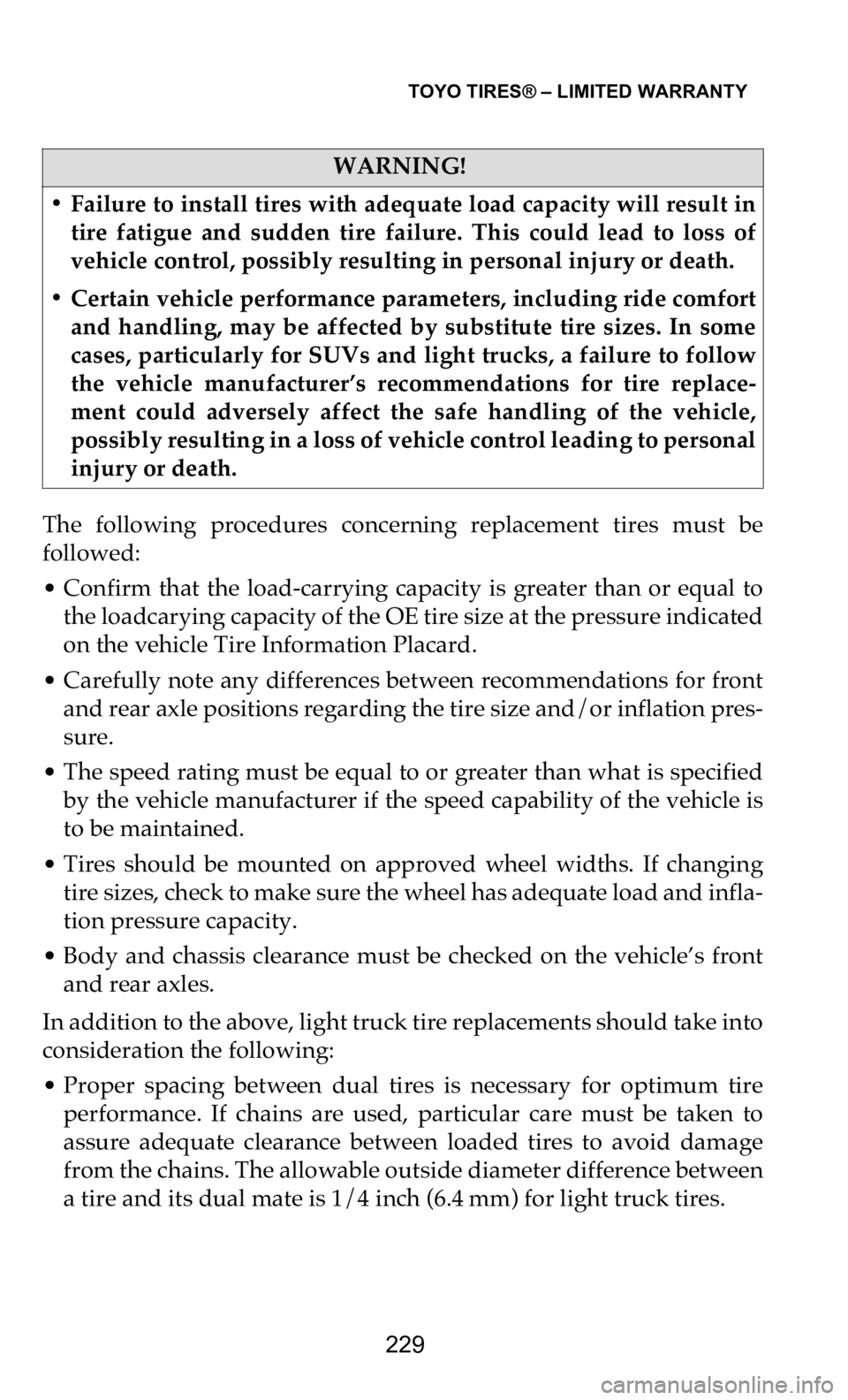load capacity DODGE CHALLENGER 2021 Vehicle Warranty
[x] Cancel search | Manufacturer: DODGE, Model Year: 2021, Model line: CHALLENGER, Model: DODGE CHALLENGER 2021Pages: 262, PDF Size: 10.42 MB
Page 230 of 262

TOYO TIRES® – LIMITED WARRANTY
229
The following procedures concerning replacement tires must be
followed:
• Confirm that the load-carrying capacity is greater than or equal to
t
he loadcarying capacity of the OE tire size at the pressure indicated
on the vehicle Tire Information Placard.
• Carefully note any differences between recommendations for front
a
nd rear axle positions regarding the tire size and/or inflation pres-
sure.
• The speed rating must be equal to or greater than what is specified
b
y the vehicle manufacturer if the speed capability of the vehicle is
to be maintained.
• Tires should be mounted on approved wheel widths. If changing
t
ire sizes, check to make sure the wheel has adequate load and infla -
tion pressure capacity.
• Body and chassis clearance must be checked on the vehicle’s front
a
nd rear axles.
In addition to the above, light truck tire replacements should take into
co
nsideration the following:
• Proper spacing between dual tires is necessary for optimum tire
p
erformance. If chains are used, particular care must be taken to
assure adequate clearance between loaded tires to avoid damage
from the chains. The allowable outside diameter difference between
a tire and its dual mate is 1/4 inch (6.4 mm) for light truck tires.
WARNING!
• Failure to install tires with adequate load capacity will result in
t
ire fatigue and sudden tire failure. This could lead to loss of
vehicle control, possibly resulting in personal injury or death.
• Certain vehicle performance parameters, including ride comfort
a
nd handling, may be affected by substitute tire sizes. In some
cases, particularly for SUVs and light trucks, a failure to follow
the vehicle manufacturer’s recommendations for tire replace -
ment could adversely affect the safe handling of the vehicle,
po
ssibly resulting in a loss of vehicle control leading to personal
injury or death.
Page 249 of 262

TOYO TIRES® – LIMITED WARRANTY
248
Tire installers should exercise extreme caution when replacing tires on
light trucks.
The maximum load capacity stamped on the sidewall of a P-metric tire
is
reduced by a factor of 1.1 when used on a light truck, a sport utility
vehicle, or a trailer.
When a P-metric or metric tire is installed on a light truck (SUV,
p i
ckup, minivan), the load rating is reduced by dividing by 1.1. (This
load reduction factor is prescribed by Federal Motor Vehicle Safety
Standards (FMVSS) and is based on the expectation that
passenger-type tires may experience more severe loading and usage
conditions when applied to light trucks.) For example, 305/50R20 has
a maximum load capacity of 3086 lbs. If this tire is fitted to a light
truck, the actual allowable load for the tire is 2805 lbs. (3086 lbs.
divided by 1.1).
Consult the load and inflation charts that can be found at
www.toyotires.com
. Contact Toyo Tires® Technical Service with any tire
replacement questions: 1-
800-442-8696 (Pacific Time) or
1-888-444-8696 (Eastern Time).
WARNING!
• P-metric and LT-metric tires are not necessarily interchangeable.
P
-metric and LT-metric tires follow completely different Load/
Inflation tables and are designed to carry different loads at
different pressures.
• LT-metric tires carry their load at higher inflation pressures and
d
o not always have adequate load capacity to replace P-metric
tires of the same size.
• After reducing a P-metric tire’s load rating by dividing by 1.1 for
f
itment on a Light Truck, the P-metric tire may not offer suffi -
cient load capacity to replace an LT-metric tire of the same size.
• Contact your Toyo Tires dealer or Toyo Tires Technical Service
f
or help determining how to choose a proper replacement size.
• Driving with underinflated or overloaded tires may result in
i
mmediate tire failure, which can cause an accident and could
lead to serious personal injury or death.